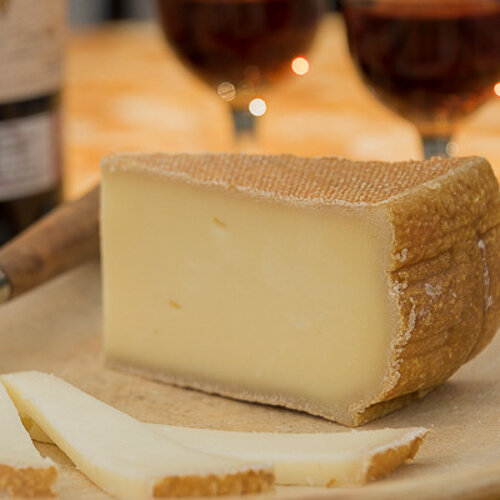The classic Roman dish, spaghetti cacio e pepe, seems to be having a moment. I have no idea why. Americans tend to prefer pasta with more stuff on it. This sauce is about as simple as it gets, although it’s easy to screw up. With Valentine’s Day on the brain, I bought a truffled pecorino recently and started to wonder if it would work in cacio e pepe. Genius, I must say.
The sauce’s name, cacio e pepe (cheese and pepper), is practically the whole grocery list. You’ll need long dried pasta like spaghetti, linguine, perciatelli or bucatini. You’ll need a pepper mill or, better, a mortar to make freshly cracked black pepper—lots of it. And you’ll need some cheese. Pecorino romano is traditional, but a truffled pecorino ups the ante.
I’m not aware of any creamery that adds the prized black winter truffles (Tuber melanosporum) to cheese. Most cheesemakers use less expensive summer truffle plus truffle aroma. The truffled pecorino I purchased was Moliterno al Tartufo (pictured below), an aged sheep’s milk cheese from southern Italy that’s injected with truffle paste. I guarantee you the truffle aroma persisted in the dish.
Despite the few ingredients in this recipe, there’s some technique involved. The cheese needs to melt into a creamy sauce, but it wants to clump. Kenji Lopez-Alt’s method, which I stumbled on online, is convoluted but foolproof. It works if you follow it.
Cacio e Pepe al Tartufo
Moliterno al Tartufo
Lopez-Alt’s method involves some back-and-forth between two skillets but it works. The sauce comes out creamy, as it should. Have the wine poured and be ready to eat. This dish waits for no one.
6 ounces spaghetti
2 tablespoons extra virgin olive oil
2 teaspoons unsalted butter
1 teaspoon freshly cracked black pepper
Pinch of kosher or sea salt
½ cup freshly grated Moliterno al Tartufo or other truffled pecorino, plus more for garnish
Put the spaghetti in a 12-inch skillet with lightly salted water to cover by about ½ inch. Have ready a tea kettle of boiling water in case you need more. Bring the water in the skillet to a simmer over high heat and cook until the pasta is al dente, according to package directions. Add boiling water from the tea kettle if needed to keep the spaghetti covered.
While the pasta cooks, put the olive oil, butter, black pepper and salt in a 10-inch skillet over medium-low heat. When the butter melts and the mixture begins to sizzle, set it aside.
When the pasta is almost ready, add about 2 tablespoons of the pasta water to the oil in the skillet. With tongs, lift the spaghetti out of the pasta water (don’t shake it dry) and into the smaller skillet. Pour off but RESERVE the pasta cooking water, then transfer the contents of the smaller skillet to the now-empty large skillet. OFF THE HEAT, add the grated cheese and begin tossing and stirring vigorously, adding a splash of the reserved pasta water if needed to make a creamy sauce. The cheese should melt, not clump. Divide among two bowls, top with a little additional cheese and serve immediately.
Serves 2
Cheese Class: Raw-Milk Cheese Showcase
Wednesday, April 15
Silverado Cooking School
Napa
5:30 p.m. to 7:30 p.m.
Reserve
We’ll celebrate tradition in this class devoted to cheeses made exclusively with raw milk. For many purist cheesemakers, in the U.S. and abroad, working with full-flavored, unpasteurized milk is non-negotiable. Come taste some standouts.



